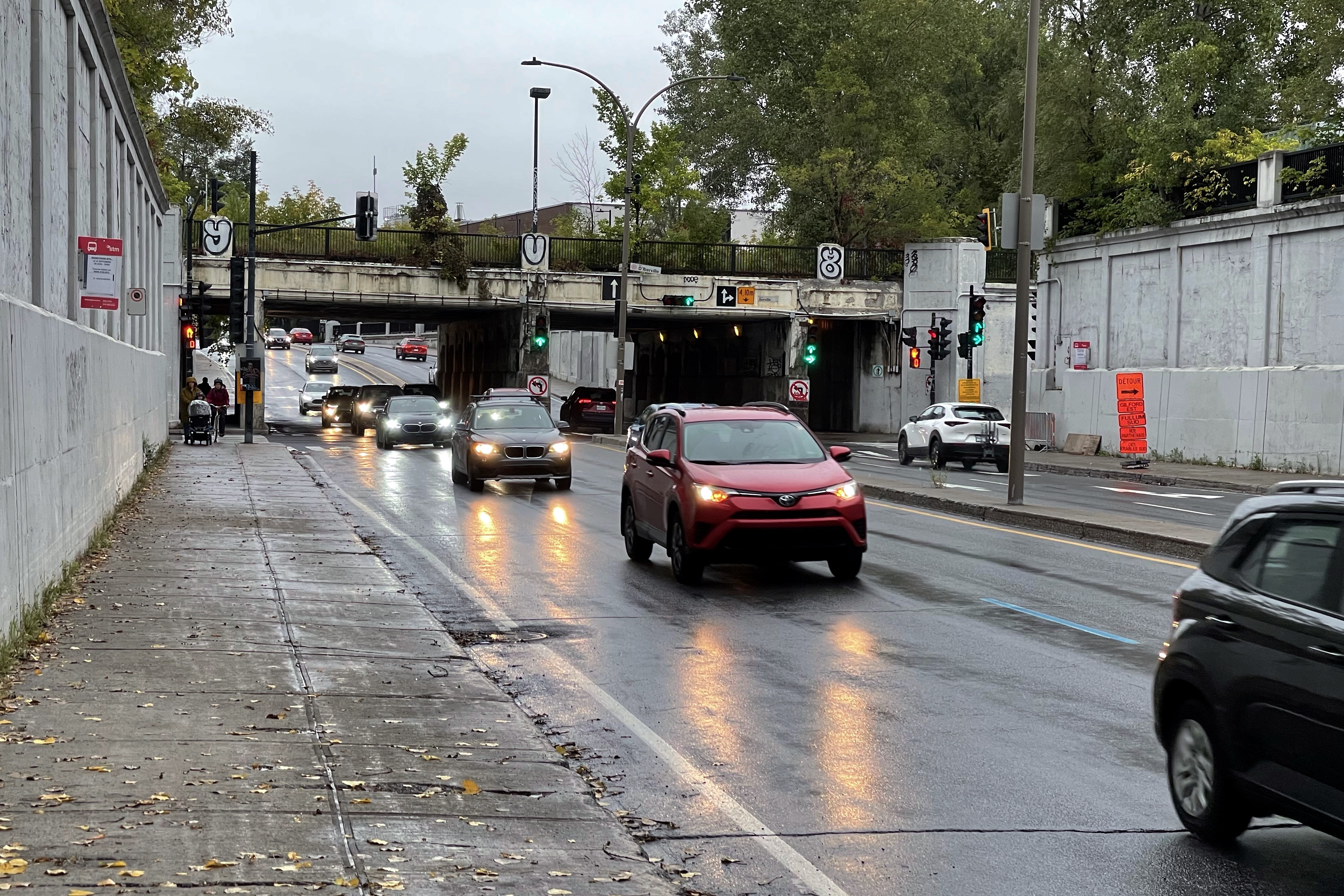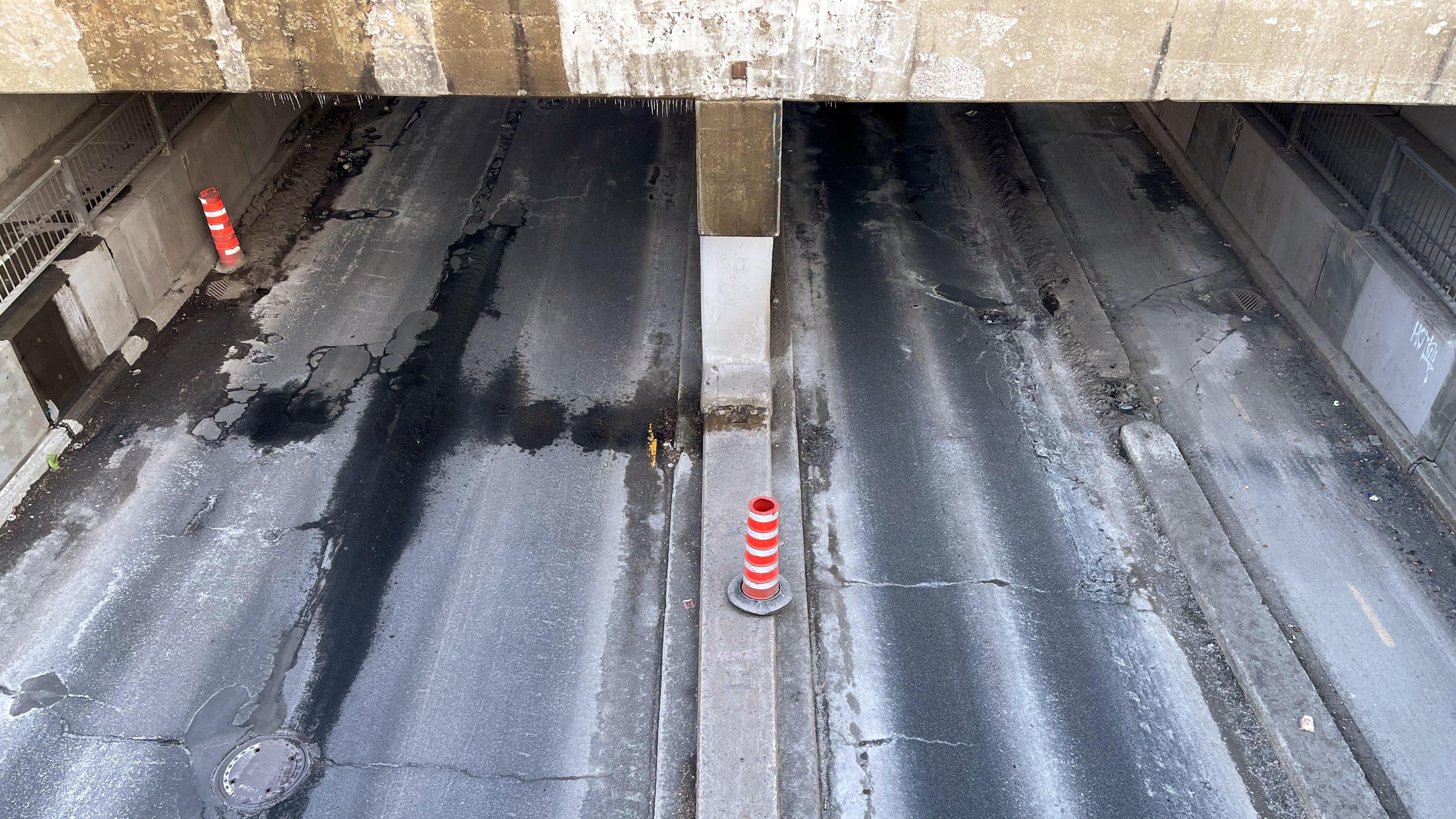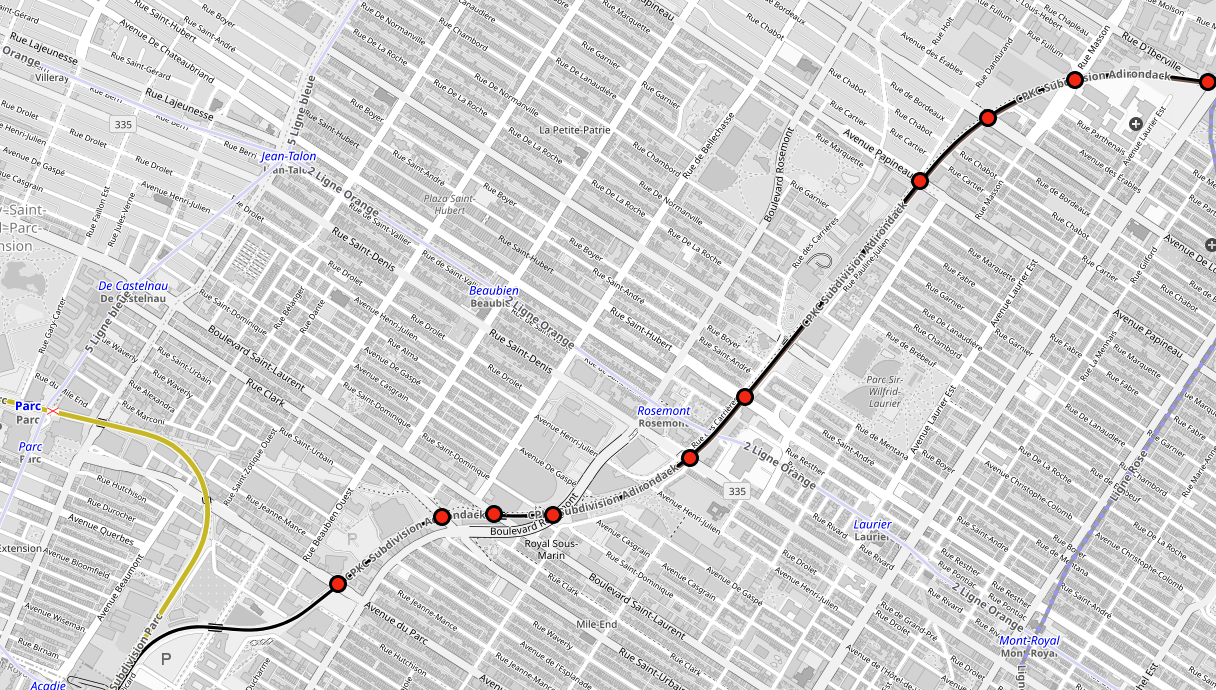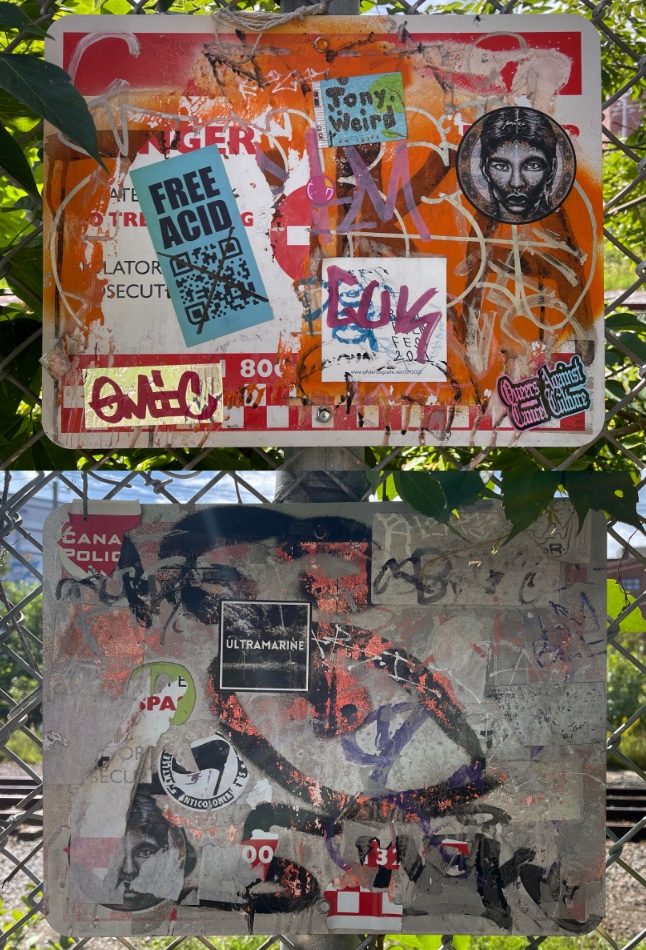
Welcome to Death Crossroads.
That’s not its real name, but how I refer to it; my own special bastardisation of the French “Tunnel de la mort” (lit. “Tunnel of death”), an intersection in Montreal seemingly notorious enough to deserve its own Wikipedia entry. The page claims 250 serious accidents reported between 1992 and 2002, and who knows how many more in the following two decades?
It might be a push to say it’s the worst place in Montreal. But whenever I walk through there, it certainly feels like it.

In the first part of this trilogy, The Montreal Lowline, I lauded the virtues of a pleasant foot and cycle path paralleling the Canadian Pacific (CP) railway tracks along the boundary of Montreal’s trendiest boroughs: Le Plateau-Mont-Royal and Rosemont-La Petite-Patrie. Yes, Montreal borough names are a mouthful because reasons, so I’ll just refer to them as The Plateau and Rosemont respectively.

In between these two boroughs lies a railway line cutting a scar through this part of the city. It makes getting from A and B require a long detour, even when you can see your destination mere metres from where you’re standing.
It divides two walkable and charming neighbourhoods with a limited series of threatening, anti-human underpasses – and one overpass – turning what should be a 1 minute trek into an unpleasant detour which can take up to 20 minutes.
Death Crossroads is one such example, but there are many others. If you think I’m being melodramatic, let me demonstrate what I mean with a short video as it will help define the context for the rest of this post:
Here I am, literally 10 seconds from where I want to be, if only I were to cut across the live freight line in front of me. But there’s no safe way across, and therefore a long detour is required. It’s bonkers.

Let’s try and pick apart:
- How this situation came to be
- Why it remains such a stubborn divide
- What possible solutions there are
- Why none of these solutions have been implemented
The Long Way Around
City planning in the early to middle parts of last century wasn’t what it is today. The assumption was we would all drive everywhere, because walking, cycling and public transport was for losers. In my home country of the UK, there’s an apocryphal tale of Margret Thatcher stating anyone over the age of 25 who had to use a bus was a failure in life.
This kind of short-sighted thinking gave rise to the suburban sprawl we live with today, and in cities resulted in some unpleasant infrastructure which was never made with people in mind.

The above map demonstrates all the available points where there’s an underpass going beneath the freight line. Crossings are also at varying distances from each other, meaning a laborious route to get down and under.

Walking or cycling through one of these underpasses deeply unpleasant experience. The exhaust fumes from the cars and trucks tends to sink in under the bridge. You’ll either need to hold your breath or just accept you probably shaved a few moments off your life expectancy.

The long sidewalks under the bridge also have no way to quickly escape in an emergency. When you’re forced to use one at night, you may wonder how you can easily get away if you’re attacked. The answer is not easily, as there’s usually a sheer wall on one side, fast traffic on the other and a long way to run back to safety.
I wouldn’t be surprised if some people felt safer waiting for a bus or taking a much more circuitous route than braving these intimidating spaces, especially in the hours of darkness.
There have also been a number of incidents in these underpasses where cyclists have lost their lives, usually when mingling with the traffic. Until recently the local by-laws required cyclists to share the road with cars rather than use the sidewalks. These incidents are often commemorated by so-called “ghost bikes”.

In a few instances, the city has built a separated bike lane under the bridge, but in others the city has had to relent to allowing cyclists to share the sidewalk with pedestrians rather than insisting cyclists risk themselves in traffic.
Naturally, this isn’t an ideal solution for either cyclists or pedestrians due to the narrowness of the pathways. If you’re walking you’ll need to constantly keep your eye out for bicycles on the narrow pathways and likewise cyclists need to weave in and out of pedestrians whilst being constrained within this narrow space.

Additionally, the road which is normally level with the railway needs to take a sharp dive to get under the bridge, and rise back up with an equally steep gradient. Some cyclists may not mind a good workout cycling up from the dip, but I wonder how many riders making frequent trips would prefer a level cycle path away from the traffic.

At the most severe end of these underpasses is the aforementioned Death Crossroads, which differs from the others in being a particularly nasty intersection with poor visibility for motorists, cyclists and pedestrians alike. I have several times seen broken car parts on the sidewalk, implying there are frequent incidents.

And let’s also talk about how loud these underpasses are. When there’s a lot of traffic going past, the concrete reflects and amplifies the sound of passing vehicles to an uncomfortable level. Throw in a large truck or two, and the sound is deafening.
At best, these underpasses are deeply unpleasant to traverse. At worst, they’re deadly.
Oh, and they also flood in inclement weather. And did I mention the copious amounts of pigeon guano you’ll get to see?
It makes me wonder how many people opt to jump in their car for a short journey over the tracks just to avoid the nastiness of these underpasses.
The Risky Shortcut

One of the ongoing problems along this freight line is people – understandably – trespass onto the railway in order to find a shortcut.

There’s no question that many locals who have to make the trip across the track regularly have decided it’s less hassle to just go over the tracks to get where they need to go.

Holes are regularly cut in the fences on each side of the line just as quickly as Canadian Pacific (CP) can repair them. It’s not uncommon to see folk dismounting their bikes, picking them up, and carrying them through a hole in the fence to get to the other side.
The dangers of trespassing onto freight lines are well known. Regrettably, a number of people have been killed in collisions with freight trains in the neighbourhood.
These trains are long and can take many kilometres to stop. There’s no way one of these goliaths can successfully break in time if you can’t get out of the way. Crossing the line in a place not designated for crossing is always going to incur the risk of taking your life into your own hands, even if the chances of injury are small.
To get an idea of the size of these trains, take a look at this short video:
The Canadian government and the various railway companies have implemented an information campaign, Operation Lifesaver, to promote rail safety and help educate people on the dangers of crossing live railway track.

But in many ways this is to just push responsibility for safety onto the individual level, instead of investing in infrastructure to allow people to cross without risk.

In efforts to try and deter trespassers CP have security teams patrolling the line, trying to catch people incurring and issuing sizeable fines. This however hasn’t succeeded in stopping people from continuing to cross in lieu of any better alternatives than the underpasses.
There’s even a website dedicated to tracking the status of these unofficial crossings in real time.

The Battle for a Crossing

If you’ve reached here, you’re probably thinking “Hey, this sounds like an intolerable situation. Why the don’t they just put in some level crossings? Or some pedestrian overpasses?”
Where do we start with this? Local residents have been campaigning for a safe crossing for years, but to no avail. Inaction has been blamed on an an on-going dispute between the City of Montreal and CP as to who’s responsibility it is to resolve the situation.
CP outright refuses to have pedestrian crossings installed due to logistical and safety concerns, a position backed up by Transport Canada.
It seems even a death on the tracks hasn’t been enough to make the various parties work to end the stalemate. So, if we can’t have a level crossing, is there another option?
A Bridge Too Far?

Canadian Pacific have evidently agreed to allow the city to build a pedestrian overpass, but thus far the city hasn’t factored this into any of their planning. Like Canadian National, they site safety concerns as a reason for inaction.

But building a safe pedestrian and cycling bridge over the freight line need not be a risky or expensive undertaking. As demonstrated by this story from the UK, such bridges can be assembled at low cost next to the railway and moved into place, so-called “lift and shift”.
Such bridges are common other countries which adhere to equally strict safety standards as Canada, so it’s a mystery why such infrastructure is so rare here.
A Similar Blight in Other Neighbourhoods and Cities
The phenomenon of these underpasses isn’t just confined to my local Montreal neighbourhood. There are many such freight lines throughout the city, and they divide neighbourhoods in the same way.
In Pointe-Saint-Charles, residents have taken matters into their own hands in a dispute with another national freight operator, Canadian National.
In neighbouring Toronto, there are similar infrastructure problems associated with the railways.
The crux of the problem is in getting the different authorities to work together. You have the owners of the railway line (CP in my case), Transport Canada and then the city and the local borough. All can keep throwing the hot potato between each other and never a consensus is reached or a solution implemented.
The Future

There is some good news on the horizon however. The city is working on improving one of the underpasses.
For example, Christophe-Colomb is a busy cycling route where collisions between cyclists and pedestrians have been common in the past. As a result, it’s being reworked as a thoroughfare for active transport.
But beyond that, it’s not clear whether the cheaper simpler solutions such as crossings and bridges will be implemented. Montreal has a history of prioritising expensive construction projects over proven common sense solutions.
It’s clear so much of this 50’s infrastructure which is part of the city’s legacy was never made with people in mind. In a city committed to Vision Zero, increasing walking and cycling and reducing car dependency matters.
And a truly impactful measure of such success is when getting between points A and B is as effortless a journey for pedestrians and cyclists as it is for motorists.

Next time we’ll get out the crayons and ask ourselves why this freight line couldn’t have a passenger service as well.
Small shout-out to both Montreal City Weblog and London Reconnections Friday Reads which both have incredible archives of links regarding Montreal and transit matters respectively.